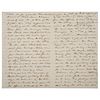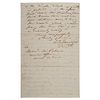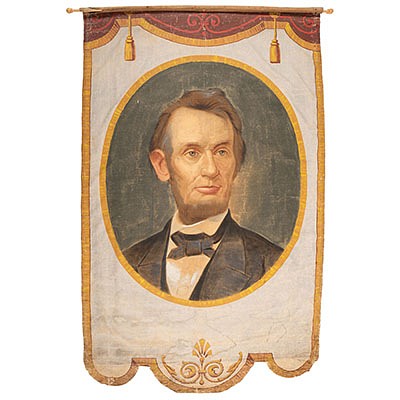[BATTLE OF MOBILE BAY]. FARRAGUT, David Glasgow (1801-1870). Autograph letter signed ("D.G. Farragut"), as Rear Admiral, to James Shedden Palmer (1810
About Seller
6270 Este Ave.
Cincinnati , OH 45232
United States
With offices in Cincinnati, Cleveland and Denver, Cowan’s holds over 40 auctions each year, with annual sales exceeding $16M. We reach buyers around the globe, and take pride in our reputation for integrity, customer service and great results. A full-service house, Cowan’s Auctions specializes in Am...Read more
Two ways to bid:
- Leave a max absentee bid and the platform will bid on your behalf up to your maximum bid during the live auction.
- Bid live during the auction and your bids will be submitted real-time to the auctioneer.
Bid Increments
| Price | Bid Increment |
|---|---|
| $0 | $25 |
| $500 | $50 |
| $1,000 | $100 |
| $2,000 | $250 |
| $5,000 | $500 |
| $10,000 | $1,000 |
| $20,000 | $2,500 |
| $50,000 | $5,000 |
| $100,000 | $10,000 |
About Auction
Jun 25, 2021
The June 25 American Historical Ephemera and Photography Auction features an exciting assemblage of 18th-early 20th century material, including Civil War archives, Early Photography, Western Americana, Autographs and Manuscripts, and more. Cowan's Auctions dawnie@cowans.com
- Lot Description
4 pages, 8vo, on Western Gulf Blockading Squadron letterhead, old creases.
Written four days after this decisive Union victory at the Battle of Mobile Bay. In January 1864, Palmer was made Senior Officer of Naval forces on the Mississippi in the vicinity of New Orleans. In August he became Commanding Officer of the First Division of Ironclads, Western Gulf Blockading Squadron, with the USS Richmond as his flagship. He served under Farragut at the Battle of Mobile Bay. Farragut discusses the battle and its immediate aftermath in some detail. He laments the loss of the USS Tecumseh to torpedos commanded by Tunis Craven: “But oh: a sad fate was that of poor Craven & his officers & men—she disappeared in a moment—but we paid them for it in the end as well as we could. Our ship [the Hartford] suffered more from colliding with the Lackawanna than from the enemy’s shot. Two ports were breached into one but we are all right again and can fight those two guns just as well as before. The tin clad Stockdale [Tinclad No. 42] has paid for herself twice over if she never does any more for Uncle Sam. But for her we would not have disposed of the Rebel soldiers in a week or landed our own at Petit [Bois Island]."
Having anchored at Petit Bois Island on August 2, the Stockdale steamed to Dauphin Island, where all of her boats were used to land troops from Army transports. “I demanded the surrender of Fort Morgan yesterday, but [General Richard L.] Page says he will die in the last ditch.” The fort did, in fact, surrender shortly thereafter on August 23rd after heavy bombardment. Farragut continues: “I will send you all of the officers and crews of the [CSS] Tennessee and Selma to be exchanged by [Maj.] General [Edward Richard Sprigg] Canby’s [Com. Military Division of Western Mississippi] Commission for the officers and men belonging to the Navy—except [Admiral Franklin] Buchanan [commander of CSN forces at Mobile Bay and the only Admiral in the Confederate Navy—aboard the CSS Tennessee during the battle], Johnson [sic, James D. Johnston, commanding the CSS Tennessee], Murphy [sic, John D. Murphey, commanding the CSS Selma], and Bradford. The last was the 1st Lt. of the Tennessee, the 1st lt. of Selma was killed. [George W.] Harrison [commanding the CSS Morgan] made his escape & got up to Mobile in the Morgan. The Gaines ran on shore sinking, & they burnt her yesterday.”
Farragut has Palmer in charge of overseeing the preparation of the smoke stack for the Tennessee. “I had her towed up under the Fort yesterday...I am told that Johnson [sic, Johnston], her former Captain, went into fits about it—so to save his feelings I will send him to Pensacola today along with the other tin clad & the smoke stack as quickly as possible.”
The Richard B. Cohen Civil War Collection Lots 79-98; 116; 138-153; and 266
Cowan's is pleased to offer the third installment of Richard B. Cohen's collection of Civil War Brown Water Navy photography. Richard was known to many in the field as a "disciplined collector who maintained a relatively narrow focus having built an important, perhaps unsurpassed collection in his area of specialization." From cartes de visite to large format photographs, this portion of the collection features a noteworthy selection of images of Brown Water Navy warships, among them, the USS Benton, Choctaw, Lafayette, and Louisville. Many important identified naval officers are also represented, including an exquisite CDV of the promising young officer, Lieutenant Commander William Gwin, who died of wounds aboard the USS Benton following an artillery duel with Confederate forces at Snyder's Bluff, and an exceptionally large war-date photograph of the controversial commander of the USS Pittsburgh, Egbert Thompson.
This auction also features a premiere selection of autographs and manuscripts from Richard's carefully curated collection. Highlights include a letter from Jefferson Davis to his distant cousin, John J. Pettus, Governor of Mississippi, dated a year before secession, conveying intricate plans for securing armaments in preparation for the war; an Abraham Lincoln signed endorsement; a letter from Admiral D.G. Farragut from New Orleans, offering excellent insight into his "political" thinking as well as his dedication to his work; correspondence from Gideon Welles, David Dixon Porter, U.S. Grant, and W.T. Sherman; and a pair of superb letters with highly descriptive accounts of the Battle of the Monitor and Merrimac.
Provenance: The Richard B. Cohen Civil War Collection - Shipping Info
-
SHIPPING & PICKUPS Cowan’s Cincinnati Office offers an in-house, full-service shipping department which is unparalleled in the auction industry. Shipping costs are provided with your finalized invoice 24-48 hours after auction. For furniture and oversized items, we recommend using third-party services. For more information, contact cowansshipping@hindmanauctions.com. NOTE: All pickups and preview are by appointment only. To make an appointment, please call 513-871-1670 or email cincinnati@hindmanauctions.com Buyers are required to pay for all packing, shipping and insurance charges. Overseas duty charges are the responsibility of the successful Bidder. Be aware that for larger and/or valuable items, shipping charges can be substantial. - Shipping charges include insurance for your order while in transit. If you have private insurance we will adjust your charge to include only packing and shipping. - Please allow 14 – 21 days after payment to package and ship your purchase as carefully as possible.
-
- Buyer's Premium



 EUR
EUR CAD
CAD AUD
AUD GBP
GBP MXN
MXN HKD
HKD CNY
CNY MYR
MYR SEK
SEK SGD
SGD CHF
CHF THB
THB![[BATTLE OF MOBILE BAY]. FARRAGUT, David Glasgow (1801-1870). Autograph letter signed ("D.G. Farragut"), as Rear Admiral, to James Shedden Palmer (1810](https://s1.img.bidsquare.com/item/l/8589/8589815.jpeg?t=1LMY9S)
![[BATTLE OF MOBILE BAY]. FARRAGUT, David Glasgow (1801-1870). Autograph letter signed ("D.G. Farragut"), as Rear Admiral, to James Shedden Palmer (1810](https://s1.img.bidsquare.com/item/s/8589/8589815.jpeg?t=1LMY9S)












